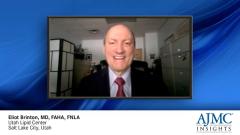
HoFH Treatment Landscape
The treatment landscape of HoFH is discussed by Eliot Brinton, MD.
Episodes in this series

Eliot Brinton, MD: A very important question in any aspect of lipidology is are you managing LDL [low-density lipidprotients] primarily? And if you are, then LDL management is driven by LDL goals. And the kind of standard one-size-fits-all goal for LDL is less than 70, or even call it a threshold over 70, doesn’t matter, same story. And that is primarily used for patients who have had a prior cardiovascular event. Might be used for a patient without a prior event, but really super high-risk like say a very, very high calcium score say over 1000, 3000. For those patients, you probably want to get the LDL to less than 70. And the corresponding goal for non-HDL [high-density lipoprotein] would be 30 points higher, or less than 100. We do have more goals now. Less than 55 was first presented by the AACE [American Association of Clinical Endocrinology] guidelines in 2017. More recently by the Europeans, and now by other American organizations; Less than 55 with recurrent disease, severe disease. Logically you would think that this would be an appropriate goal for patients with HoFA [familial hypercholesterolemia; HoFA], but maybe surprisingly, maybe not surprisingly the goal in those 2 guidelines that I mentioned earlier is actually less than 70, and there’s a reason for that. And the reason is that it’s really hard to get a patient [with HoFA] a goal. It’s so hard because not only do they start very, very high; their LDLs at baseline are super high. But also they tend to respond poorly to treatments. And the reason is that most of our treatments are based on LDL receptor upregulation. And by definition, HoFA is driven entirely by either large impairment or absence of LDL receptor function. That’s really the heart and core of the cause of HoFA. Everything we’re talking about stems from severely impaired to absent LDL receptor function. And these medications that we use, and use very successfully for polygenic hypercholesterolemia or monogenic heterozygous FH work very well in HoFA, there is little, or in many cases no effect of our traditional treatments.
The treatment of HoFA is really critical. These are people that are going to have huge morbidity, and become disabled, and they’re going to die at young ages. Aside from making the diagnosis, which of course, has to be the first step, treatment, is the critical question. And just briefly, what we do is we do the usual cascade or sequence of LDL lowering treatments. Even though I just said that these patients don’t respond well, we go through the treatments anyway. And we don’t take a year or 2 with each treatment; we may take a few months with each treatment. But we always start with statins. We can start with low or high intensity. There is a difference. And we can try to do high-intensity [treatment]. One important fact about statins is that there’s only about a 6% extra LDL lowering with each doubling of the dose. We can start with atorvastatin 80, rosuvastatin 40. That’s wonderful, but we don’t give up too much if we’re starting at a lower dose. And of course, we’re dosing children here, so we tend to use lower doses anyway. We’ll start with a statin at whatever dose we choose. If we want to try to titrate the statin dose, we can. But there is very little benefit to serial titration dosing, so pick a dose of a statin and just go with that, and hope that the patient won’t have adverse effects. If they do, then we may have to stop and then go to a lower dose, or even switch to a different statin. But generally, we use either atorvastatin or rosuvastatin and we will go to a middle dose if it’s a young child because that’s the equivalent of the highest dose that we would use in an adult. We start there. The second step always should be ezetimibe. Now ezetimibe is not terribly effective. It only gives us about a 20% LDL lowering, whereas the high-intensity statins will give us 55% or so LDL lowering. But remember that the 20% is the equivalent of 3 doublings of a statin. If we are nervous about giving a higher dose of a statin, we can start with the middle dose let’s say, and then add ezetimibe. And we’re going to get whatever we’re going to get with LDL receptor upregulation with those 2 very cheap and generic drugs. With the newly released data on bempedoic acid shows a clinically and statistically significant reduction in cardiovascular outcomes, I’m now more inclined to use bempedoic acid as a third-line [therapy]. Again the efficacy is fairly modest, although it is fully additive to ezetimibe. And if a patient is statin intolerant, then it works a little bit better. We’ll do at least a statin and ezetimibe, possibly bempedoic acid. Another step, which is a very important step, is to use a PCSK9 [proprotein convertase subtilisin-kexin type 9] inhibitor. We’ve got the monoclonal antibodies, which will lower antibodies by 60% in non-FH patients, and pretty close to that in heterozygous FH patients. And then we’ve got the new 1, which is inclisiran, the sRNA medication. And that is a little bit less effective, but still quite potent for LDL lowering in patients who don’t have HoFA. Now, these drugs work through the LDL receptor, so they will work fairly well for HoFA. And they tend to work rather poorly for HoFA, but it’s worth a try. We go through all these steps. Generally, we’ll just pick 1 of the PCSK9s, so no need to worry about trying both types of drugs. But we’ll go through all of those drugs, and that really is 4 classes of drugs if we count the bempedoic acid in the middle. And then what happens? Often the response is poor. And tragically the response tends to be inversed at the baseline. Somebody comes in with a baseline LDL let’s say 500. They may well get a decent response to any 1 or more of those 4 basic medications. And if they come in with an LDL of say 800 or 900, then their response on a percentage basis is actually usually lower. I’ve seen patients who get worse than no response, no discernible response to any of those 4 classes that I just mentioned. Which is just really crazy, but that’s just how it is. For HoFA, we go through the standard treatments, but we go through them fairly quickly with the idea that we are unlikely to get as far as we need to go. Even if you start out at 500, and let’s say you get half the response that you expect with all these medications. Instead of a 50% response with a statin, you get say 25% instead of 20%. With ezetimibe, you get a 10% instead of a 60% response with a PCSK9. With a monoclonal antibody, you’re getting 20% or let’s say 30%. You do the math, you’re nowhere near goal. You haven’t made it down to a goal of less than 70% with all of those medications as best you can. Then the question is, what’s next? And that’s where HoFA treatment gets even more interesting after you’ve gone through all the treatments that we use for anybody with high cholesterol as needed.
Transcript edited for clarity.
Newsletter
Stay ahead of policy, cost, and value—subscribe to AJMC for expert insights at the intersection of clinical care and health economics.










































